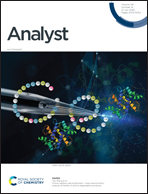Facile and efficient preparation of organoimido derivatives of [Mo6O19]2− using accelerated reactions in Leidenfrost droplets†
Abstract
Reaction acceleration is a hot topic in recent years since it is very useful for rapid reaction screening and small-scale synthesis on a short timescale. It is known that the rates of chemical reactions are often accelerated in confined volumes (small droplets or thin films) where the unique chemical reactivities of molecules at the air–droplet/thin film interface, usually different from that in the bulk and gas phases, play a dominant role in acceleration. The Leidenfrost effect was employed to create small levitated droplets with no net charge. These droplets can accelerate many kinds of organic reactions. Our first accelerated synthesis of a series of organoimido-functionalized polyoxometalate (POM) clusters using Leidenfrost droplets with product analysis by electrospray ionization mass spectrometry (ESI-MS) demonstrated that this method can be successfully extended to the synthesis of inorganic/organic hybrids, a very promising area for developing POM-based functional materials. Comparable amounts of synthetic products [Mo6O18(NC6H4R)]2− (R = H (6), m/z 477; p-i-C3H7 (7), m/z 498; p-OCH3 (8), m/z 492; p-NO2 (9), m/z 500) were prepared within minutes in Leidenfrost droplets versus in hours in the corresponding bulk reactions under the same reaction conditions in the presence of the DCC catalyst, suggesting that both concentration and interfacial effects are pivotal in causing reaction acceleration in the Leidenfrost droplet. Compared to the conventional bulk reactions, the acceleration factors (AFs) were 92, 136, 126, and 89 for the four model reactions (1)–(4), respectively. We also found out that substitution affects the rate of reactions occurring in droplets, and hence the magnitude of AF. The rates increase in the order of R = NO2 < H < i-C3H7 < OCH3, in which the electron-donating groups (i.e., R = OCH3, i-C3H7) on the benzene ring are more favorable to the reaction than the electron-withdrawing group (i.e., R = NO2). This experimental result is in good agreement with the DFT calculation which indicates that the free-energy barriers for the direct imidoylization of POM with RNH2 are linearly correlated with the basicity constants (pKb) of amines.
![Graphical abstract: Facile and efficient preparation of organoimido derivatives of [Mo6O19]2− using accelerated reactions in Leidenfrost droplets](/en/Image/Get?imageInfo.ImageType=GA&imageInfo.ImageIdentifier.ManuscriptID=D0AN00578A&imageInfo.ImageIdentifier.Year=2020)


 Please wait while we load your content...
Please wait while we load your content...